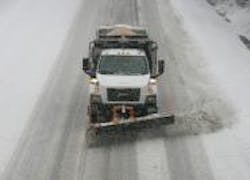“Although snow days often conjure happy childhood memories, this study makes it crystal clear that they have a tangible and serious negative impact on real working people and a wide range of businesses.” –Greg Cohen, president and CEO, American Highway Users Alliance
A new study penned by the American Highway Users Alliance (AHUA)and consulting firm IHS Global Insight looked at the economic impact dealt by the big snowstorms earlier – and the picture the data paints isn’t pretty.
The study put an estimated dollar figure on the cost of snow-related shutdowns in 16 U.S. states and two Canadian provinces, calculating that hundreds of millions of dollars in economic opportunity are lost each day that a state is shuttered by impassable roads. Further, the report also concluded that hourly workers are the most harshly impacted by such shutdowns.
[Here’s short video produced by the Virginia Department of Transportation (VDOT) explaining the intricacies of snow removal – especially in terms of what substances the agency users at what temperatures to try and keep the pavement clear.]
“Lost wages of hourly workers account for about two-thirds of the direct economic impact of a major snowstorm,” said James Gillula, managing director of Global Insight and the principal researcher of the study. “Among all workers, hourly wage workers can suffer the most painful economic losses and the indirect economic effects of their lost wages can ripple through the economy.”
If they are even close to actual, the dollars lost per DAY due to snow-related closures are truly staggering. Just look at this list:
Illinois, $400 million lost per day
Indiana, $157 million lost per day
Iowa, $70 million lost per day
Kentucky, $96 million lost per day
Maryland, $184 million lost per day
Massachusetts, $265 million lost per day
Michigan, $251 million lost per day
Minnesota, $167 million lost per day
Missouri, $162 million lost per day
New Jersey, $289 million lost per day
New York, $700 million lost per day
Ohio, $300 million lost per day
Pennsylvania, $370 million lost
Utah, $66 million lost per day
Virginia, $260 million lost per day
Wisconsin, $149 million lost per day
Ontario, $474 million lost per day
Quebec, $250 million lost per day
“This gives needed perspective on the true costs of [a weather event] often thought of as harmless and fun,” stressed Greg Cohen, AHUA's president and CEO.
“For state and local authorities, [this] serves as a wakeup call for bigger snow removal budgets. The shocking losses estimated by this study should light a fire under state and local authorities nationwide to get serious about investing in quicker and more effective snow and ice removal,” he said. “When roads are left unsafe or impassible, it is like money being thrown down the drain.”
It also reinforces that state and local authorities shouldn’t be “pennywise and pound foolish” when it comes to setting snow removal budgets, added Cathy Gillen, the AHUA’s communications director.
“If anything, it shows that states and local government need to be prepared for the worst – because this study shows that the cost of snow removal pales in comparison to the cost of a one-day snow-related shutdown,” she told me.
In Virginia alone, dealing with all of the snow that fell this past winter proved a Herculean task. VDOT estimated it removed about 500,000 tons of the white stuff northern Virginia roads ALONE – the fallout from just two big back-to-back blizzards.
[The Commonwealth of Virginia is one state that hones its snow-removal procedures year round, involving a wide range of employees and equipment. Here’s just a glimpse of what’s involved.]
The AHUA's study also examined the indirect economic impacts caused by snow closures, including lost sales tax revenue and significant losses in the restaurant, general merchandise, and gasoline industries – and such “indirect impacts” more than doubled the initial direct impact of each storm.
For example, Lynn Cook, owner of Parker’s Exxon, a filling station in Northwest Washington D.C., said that February’s back-to-back blizzards reduced business by 20% – resulting in a reduction of over $6,000 in fuel tax revenue paid to the District’s local government.
“This study illustrates an important point: disruptions in the nation’s transportation network are a cost to the economy,” noted Janet Kavinoky, director of transportation infrastructure at the U.S. Chamber of Commerce.
It just goes to show that maybe snow days aren’t all they are cracked up to be anymore.
